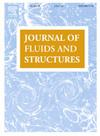机匣处理对无喷嘴径向涡轮叶片减振的影响
IF 3.5
2区 工程技术
Q1 ENGINEERING, MECHANICAL
引用次数: 0
摘要
高周疲劳(HCF)是无喷嘴径向涡轮叶片最常见的失效形式。目前对叶片减振的研究主要集中在叶片的设计优化和几何形状的修改上,通常是以增加转子重量和降低气动性能为代价的。研究了一种基于机匣处理的叶片减振流动控制方法。受广义力法的启发,提出了用壳体处理来抵消蜗壳引起的激振。在机匣上引入轴向沟槽(称为机匣处理),以减少蜗壳引起的叶片激振,特别强调由于振动幅值大而导致的高膨胀比工况。首先,通过已验证的单向流固耦合(FSI)方法,研究了蜗壳隔舌与沟槽相对位置对叶片激励的影响。结果表明,通过适当调整相对位置,可以在不牺牲气动性能的前提下显著减小振动幅值。广义力和流场分析表明,当定位正确时,蜗壳和槽所产生的广义力相互抵消。其次,研究了机匣处理尺寸参数对叶片激振的影响。其中两个参数只影响套管处理广义力的长度而不影响阶段,大大简化了套管处理的优化设计。数值计算结果表明,通过对机匣处理的优化设计,在高压比下叶片振动幅值可降低94%。研究了不同压力比下最佳套管处理的效果。优化设计在高压比条件下取得了满意的效果,但在低压比条件下仍需进一步优化。最后,通过尖端定时实验验证了套管处理的有效性,结果表明,在最关键的操作条件下,叶片振幅显著降低了48%。本文章由计算机程序翻译,如有差异,请以英文原文为准。
Blade vibration reduction of a nozzleless radial turbine by casing treatment
High cycle fatigue (HCF) is the most common form of blade failure in nozzleless radial turbines. Current studies on blade vibration reduction primarily focus on the blade design optimization and geometry modifications, typically at the cost of increased rotor weight and reduced aerodynamic performance. This paper investigates a novel flow control method for blade vibration reduction based on casing treatment. Inspired by the generalized force method, casing treatment is proposed to offset the excitation caused by volute. Axial grooves are introduced on the casing (named casing treatment) to reduce blade excitation caused by volute, with particular emphasis on high-expansion-ratio conditions due to the large vibration amplitude. Firstly, the influence of relative position of volute tongue and grooves on blade excitation is investigated via well-validated one-way Fluid-Structure Interaction (FSI) method. Results show that the vibration amplitude can be significantly reduced without sacrificing aerodynamic performance by adjusting the relative position appropriately. Generalized force and flow field analysis reveal that the generalized forces induced by the volute and the groove offset each other when positioned correctly. Secondly, the influence of size parameters of casing treatment on blade excitation is investigated. Two of the parameters only influence the length of generalized force caused by casing treatment rather than the phase, which greatly simplifies and facilitates the optimum design of casing treatment. Numerical results suggest that the blade vibration amplitude can be reduced by up to 94 % at high pressure ratio via the optimum design of the casing treatment. The effect of optimum casing treatment under various pressure ratios is also investigated. The optimum design has satisfied effect at high pressure ratio, but further optimization is required under low pressure ratio conditions. Finally, the effectiveness of the casing treatment is validated via tip-timing experiments, demonstrating a significant reduction in blade amplitude by 48 % under the most critical operating conditions.
求助全文
通过发布文献求助,成功后即可免费获取论文全文。
去求助
来源期刊

Journal of Fluids and Structures
工程技术-工程:机械
CiteScore
6.90
自引率
8.30%
发文量
173
审稿时长
65 days
期刊介绍:
The Journal of Fluids and Structures serves as a focal point and a forum for the exchange of ideas, for the many kinds of specialists and practitioners concerned with fluid–structure interactions and the dynamics of systems related thereto, in any field. One of its aims is to foster the cross–fertilization of ideas, methods and techniques in the various disciplines involved.
The journal publishes papers that present original and significant contributions on all aspects of the mechanical interactions between fluids and solids, regardless of scale.
 求助内容:
求助内容: 应助结果提醒方式:
应助结果提醒方式:


